Lamesley

Welcome to the Lamesley page which brings you a little of the history and a news item from 1857 as well as a link to the history of Ravensworth castle covered elsewhere
St. Andrews Church is the most distinctive landmark in the Lamesley village area.
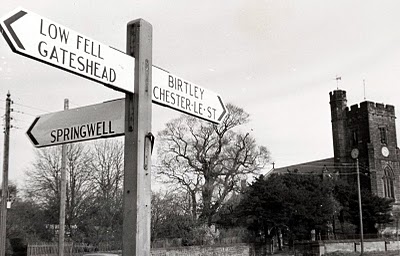
Left click to see it with a different sign
Records of an early chapel, the chapel of St. Andrew date back to 1286. Medieval grave covers can be found inside the church and the family vault of the Ravensworths lies beneath the chancel. Church registers date back to 1603 and the church font dates to 1664. The current church dates from 1758 (bell cast by John Lee 1759) and was extended in 1821, around the time the Parsonage was built, with aisles and west tower. In 1847 the chancel was re-built and further restoration work was carried out in1884.
Left click to enlarge
The Church clock commemorates 3rd earl Ravensworth who died in 1902.
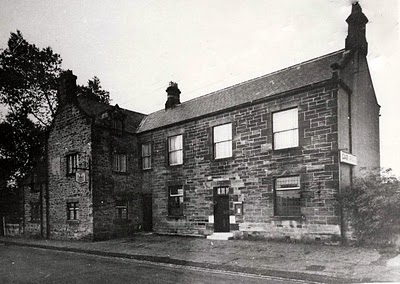
Left click to see it as it is now
The Ravensworth Arms is all that remains of the old village once known as Clubdon and stands on the site of what was once Clubdon Hall, whose last Baron was Henry Augustus Clavering - a direct descendant from one of the custodians of Magna Carta.
The Ravensworth Arms has two literary connections. Catherine Cookson's mother worked at the pub and she had a fling with one of the punters which led to the writer's birth and Lewis Carroll stayed at the pub and it is thought he wrote some of his 'Alice' adventure there
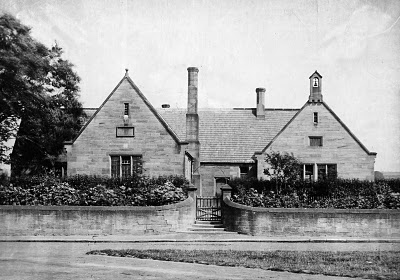
Left click to see it as it is now
School
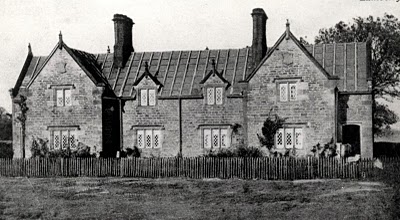
Almshouses
A little way north west of the village stands Ravensworth Castle within the Ravensworth Estate
There is evidence that Ravensworth has been occupied continuously since pre-medieval times. The earliest reference to it dates from 1080 and there was a castle on the site from the twelfth century. The first mention of the manor of Raveneshelme was in 1288 following which it passed through various hands until 1607 when it was purchased by Sir Thomas Liddell. In 1724 a 'largish but plain' house was built within the castle (which consisted only of four angle towers and a curtain wall), but this was altered and improved several times later in the century, on one occasion by Paine, breaking the curtain wall.
Following a visit by Nash in 1808 the old house was demolished except for two medieval towers incorporated in the stable yard and a new house was built to his designs for Sir Thomas Liddell (created Lord Ravensworth in 1821). After 1822 the house was much changed or rebuilt when Ravensworth's son took an active interest in the design. Lord Ravensworth retired from politics in 1832 to concentrate on building, but the house was not complete until about 1846. It was, in Pevsner's words, "the most splendid and most picturesque monument of the Romantic medieval revival in the county" with an embattled and turreted exterior and an octagonal tower appearing above the trees.
From an early date coal was mined underneath the estate and a complex pumping system was constructed to drain the workings. It was perhaps ironic that whilst it was essentially the riches derived from coal that made possible the building of the Nash house, it was as a result of coal mining subsidence that the majority of the building was demolished in 1953. Since then, apart from the building of three houses, little has happened on the estate but the principal buildings and structures that remain have steadily deteriorated through the influence of man and the weather.
The Duke of Wellington was entertained there in October 1827.
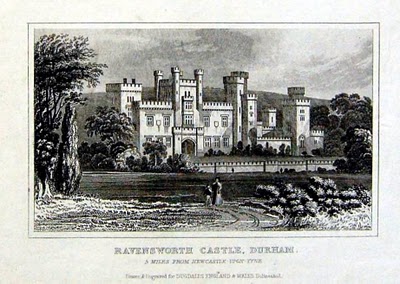
Left click to enlarge
The Liddell family ceased to live at the castle in about 1910. It was briefly leased to a girls school but gradually fell into disrepair and decay. It was substantially demolished in about 1952 when it became unsafe due to mining subsidence, some of the stone was used to extend Hindley Hall. The ruinous remains have been scheduled by English Heritage in the Buildings at Risk Register.
For photographs of the castle buildings as they are now click the link
The Castle was featured in a BBC television programme 'Restoration'.
The following is a news item of 30th December 1857.
A grand ball, on a scale of unusual splendour,
was given at the magnificent baronial residence of the Right
Hon. Lord Ravensworth, at Ravensworth Castle. The castle, the
scene of the festive gathering, is most beautifully situated a little
to the north-west of Lamesley, and occupies a gentle declivity,
sloping from the west. At a distance of half a mile westward the
ground swells to a mountainous ridge, covered with large forest
trees, and the magnificent scene closes the prospect in that direc-
tion. The southern front overlooks the vale of Ravensworth, and
the northern front faces towards the Tyne. The old castle at
Ravensworth was a place of considerable antiquity, and no doubt
also of strength, but in 1808 nearly the whole of the old house
was taken down,
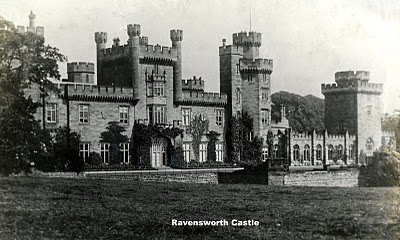
Left click the image of Ravensworth Castle to enlarge it
and the present splendid mansion erected, the
style of which is a selection from the castle architecture of different
periods. As seen from the north-east the castellated outlines are
exceedingly beautiful and picturesque. Still finer is the view as
the castle is approached through its spacious lawns, interspersed
with shrubbery and time-honoured oak and other trees,
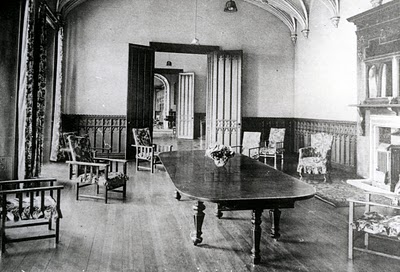
Left click to enlarge. This can only give some idea of the interior as this is a photograph of the common room when the castle became a girls'school
while the interior, in respect to architectural arrangement, beauty of decoration, and appropriate furnishing, combines magnificence with utility and comfort in a degree scarcely to be equalled and certainly not surpassed by the most splendid palatial residence. His lordship having been entertaining a numerous and brilliant company, gave a grand ball to all the leading families of the two counties of Northumberland and Durham. A numerous and effective band was present, under the able leadership of Mr. Liddle. The ball was led off by Lord Ravensworth and the Marchioness of Londonderry. The programme was exceedingly choice, and comprised the most charming and fashionable music of the day. Refreshments, varied and delicate, were provided, and everything had been marked by the utmost regularity, ease, and comfort, and notwith- standing the greatness of the gathering and the brilliancy of their reception, the whole were met and most admirably provided for, without appearing to tax anything beyond the ordinary and well conducted resources of the castle.
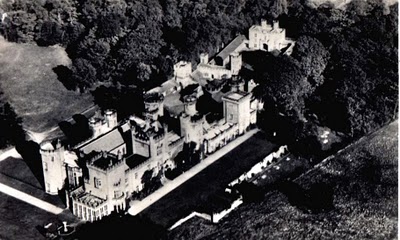
The whole history of Ravensworth Castle is here